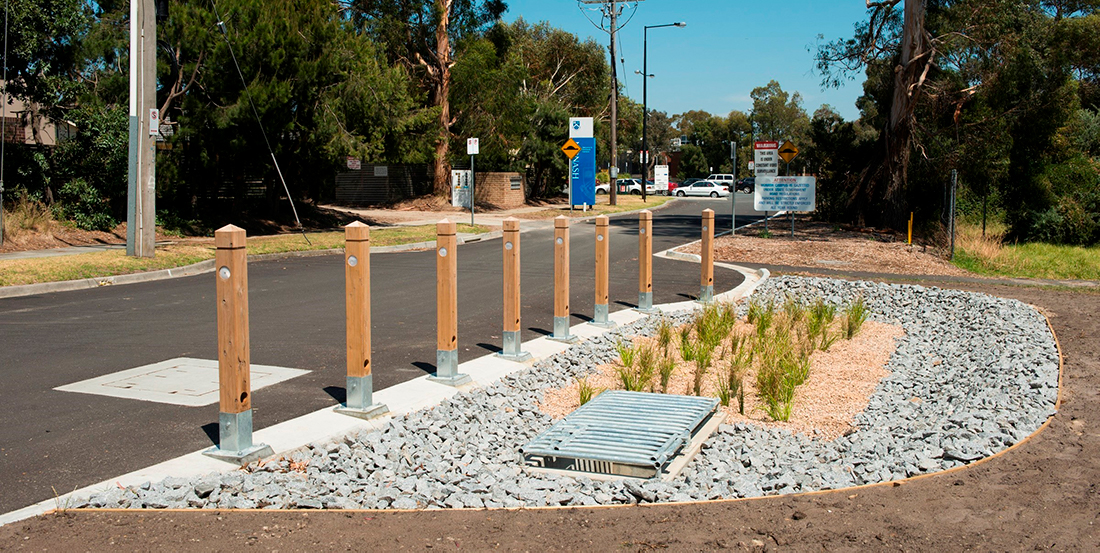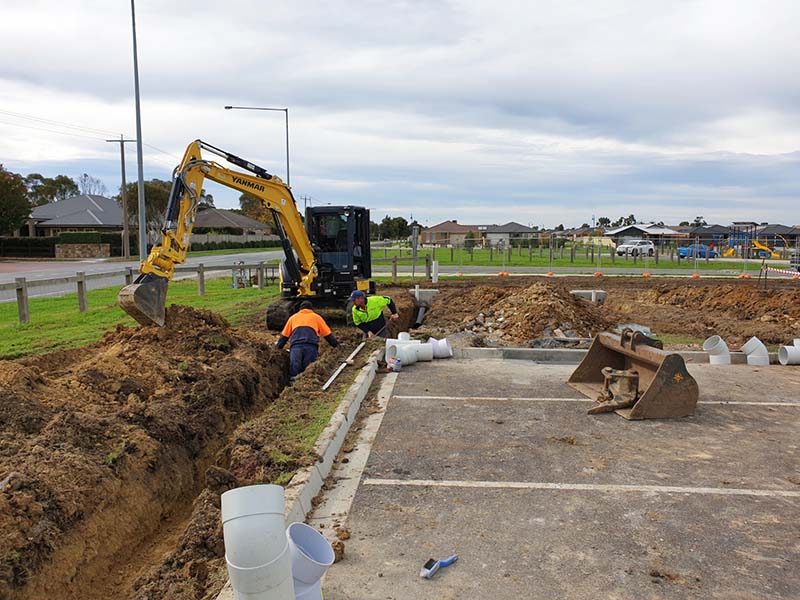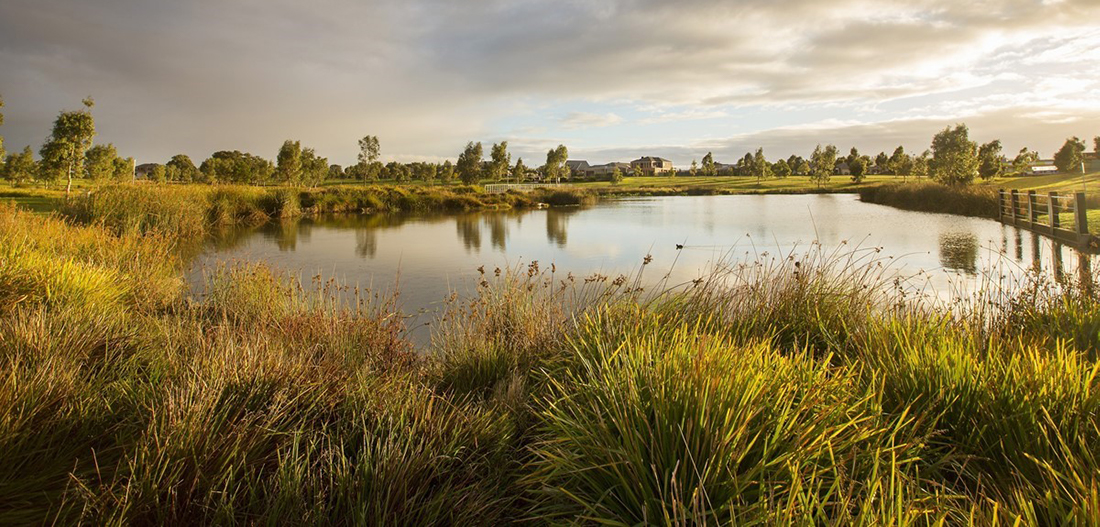Stormwater has a big impact on urban waterways
Rainfall run-off from hard surfaces like roofs and roads, carried via stormwater pipes to waterways, is the main reason for altered flow regimes and poor water quality in urban streams. This damages the habitat and living conditions for sensitive values like macroinvertebrates which are the food source for many other waterway values.
In undisturbed catchments, rainfall mostly soaks into the soil and makes its way slowly to the river once the soil is saturated. Conventional stormwater drainage (like stormwater pipes) transforms every little rainfall event into large volumes of water that scours waterways and increases the amount of nitrogen, sediment and many other pollutants. As a result, the flow regime in urban streams is known as being very ‘flashy’.
Stormwater needs to be seen as an opportunity. It can be harvested into household rainwater tanks, or stored in wetlands, for irrigating parks and playing fields. Larger stormwater harvesting schemes with appropriate treatment can also be used for water substitution. It is important that the volume, timing and quality of water is managed appropriately to support the values of each local waterway.
Stormwater as a condition integrates aspects of water quality and environmental flows and as such there is overlap with these conditions.
Values impacted by stormwater condition
Macroinvertebrates, fish, frogs, birds, platypus and vegetation
Increases in the frequency and volume of flows and the decline in water quality resulting from urbanisation impacts on all the environmental values. Impacts from altered flow regimes on rivers are many and varied, from altered physical habitats to disruption of breeding behaviours.
In addition to impacts on creeks and rivers, natural wetlands are also impacted. For example, some natural wetlands have been modified to function as flood retention systems or turned into stormwater treatment wetlands. These modifications permanently change the nature of the wetland; the wetting and drying characteristics and the ability of the wetland to support high quality native vegetation, frogs and birds.
Amenity, recreation and community connection
Conventional stormwater drainage also impacts social values by increasing litter in and along waterways and reducing water quality. Litter and odour detract from the amenity of waterways and makes them less enjoyable for recreation and community connection activities. Pathogens such as E. coli are critical to manage to minimise human health risks associated with on-water activities such as swimming, wading, paddling, and boating. Management of nutrients is also important to reduce the risk of blue-green algae outbreaks that can cause odours and require public access to be restricted.
Urban development is driving the condition of stormwater
The development of housing in new urban areas and the intensification of existing urban areas will be significant in the Port Phillip and Westernport region over the next 50 years. The condition of stormwater can be improved by harvesting runoff from hard surfaces for re-use and infiltrating as much as possible back into the soil.
Stormwater condition is measured through connected imperviousness
The stormwater condition is measured by ‘directly connected imperviousness’ (DCI). It is a unique umbrella measure that integrates all aspects of waterway condition that are known to be impacted by urbanisation (e.g. flows and water quality). DCI can be tracked through remote sensing and used as a specification in designing stormwater treatment systems.
DCI is the percentage of impervious surfaces in the upstream catchment that are directly connected to the stream reach e.g. there is a stormwater pipe rather than a raingarden, between the impervious surface and the stream. A DCI value of zero percent represents natural hydrology. Once DCI is greater than 2% the stream is typically significantly impacted.
The stormwater condition scores are based on the relationship between DCI and macroinvertebrate health. As DCI increases, macroinvertebrate health decreases.
DCI mapping is undertaken using a combination of LiDaR (Light Detection and Ranging), aerial photography, the location of stormwater pipes, overland flow paths and treatment systems such as raingardens.
Assessment of stormwater condition and the extent to which we are on the predicted trajectory will be undertaken for the stormwater priority areas to inform the mid-term review and again to inform the final review of the Healthy Waterways Strategy.
You can explore DCI condition on the Healthy Waterways Strategy Map >>

Stormwater condition baseline and targets
2018 baseline: the condition of stormwater was measured in 2018 based on directly connected imperviousness (DCI) mapping and modelling.
2068 target: the target represents what can be achieved with an increase in coordinated, collaborative and prioritised effort. It is the scenario that the Strategy partners have agreed is required. The 'target trajectory’ includes assumptions about policy being in place to enable improved standards for stormwater management, and increased investment in stormwater harvesting and infiltration.
Without additional effort, the stormwater condition across the majority of the region’s waterways is expected to worsen. Current policy and practice allow DCI to increase through new stormwater connections made as urbanisation occurs. The target trajectory includes assumptions that over the long term these policies and practices will change so new development will not increase DCI and existing urban areas will see a 25% improvement in DCI as a result of the incorporation of higher standards in the urban renewal cycle.
Number of rivers in each catchment by stormwater condition score
Hover, click or tap (on mobile) the charts below to view more information.
Baseline and trajectories in Rivers
A limitation of DCI as an indicator is that it does not capture all the benefits of stormwater or flow management interventions. For example, there may be efforts made to reduce point-source pollutants or release water from a large water supply dam, neither of which will result in a shift of DCI values. This is why it is important to have separate water quality and environmental flow conditions.
Actions to improve stormwater condition
There are a range of policy and on-ground actions that will enhance stormwater management to protect waterways.
Harvest and infiltrate stormwater
Works to disconnect stormwater from waterways needs to occur at all scales across the urban catchment. Harvesting and infiltration systems are needed to capture excess water from the catchment and to mimic the natural baseflow into waterways through the infiltration of runoff back into the ground. Examples of these systems include household rainwater tanks used for garden watering and flushing toilets, streetscape measures such as raingarden tree pits and large-scale water capture and reuse schemes.
Some river systems in the region are flow stressed in a different way. Pumping water from waterways for irrigation purposes and large water supply dams can significantly reduce flows in a reach. The use of stormwater may be an appropriate measure to replenish flows in these systems.
In the Strategy, priority areas were established to guide where actions to harvest and infiltrate stormwater will deliver the most effective outcomes for waterways.
Explore these priority areas on the map >>

2021 Case study: Shading, cooling and greening Melbourne’s public spaces
Merging the need to provide more shade and greenery in our urban areas with the need to reduce volumes of stormwater running off hard surfaces and into waterways is a perfect marriage.
Build and maintain stormwater treatment systems
Melbourne Water, developers and councils invest significantly in building different types of stormwater treatment systems to reduce nutrient and sediment impacts to waterways and bays. Maintenance of these systems to meet their intended design is crucial to meeting stormwater condition targets.
In the Strategy, actions to build and maintain systems will reduce the impacts of stormwater on waterways.

Update the planning system to promote stormwater capture and reuse
The current best practice guidelines for urban stormwater focus on reducing nutrient and sediment loads but are lacking adequate requirements for runoff volume.
Enhancing the draft urban stormwater management guidance to include targets for runoff volumes and more stringent requirements around stormwater runoff will go some way towards achieving the strategy targets.
The Strategy includes actions to ensure standards, tools and guidelines are in place to protect waterways.
Protect headwater streams
Protecting headwater streams has been identified as a key area of improved stormwater management. Headwater streams are small waterways in the upper reaches of the catchment which are generally only intermittently wet and may not have a well-defined channel. Through the process of urbanisation they have traditionally been constructed into much larger channels to convey large volumes of stormwater or are they are piped underground.
The Strategy recognised the value of headwaters in their natural state to retain the natural flow regime and assist in nitrogen processing. Actions include the development of protection mechanisms for headwater streams.
Increase industry capacity
Building capacity to understand, design and implement the stormwater targets across the industry (i.e. Melbourne Water, council staff, developers and consultants) is critical. The strategy included actions to increase industry capacity.

Stormwater Victoria is demonstrating leadership and collaboration across Melbourne to meet stormwater outcomes
Stormwater Victoria supports the stormwater targets of the Healthy Waterways Strategy and provides leadership to the sector to implement integrated water management options to achieve protections for waterways and the development of pleasant open spaces for the community.